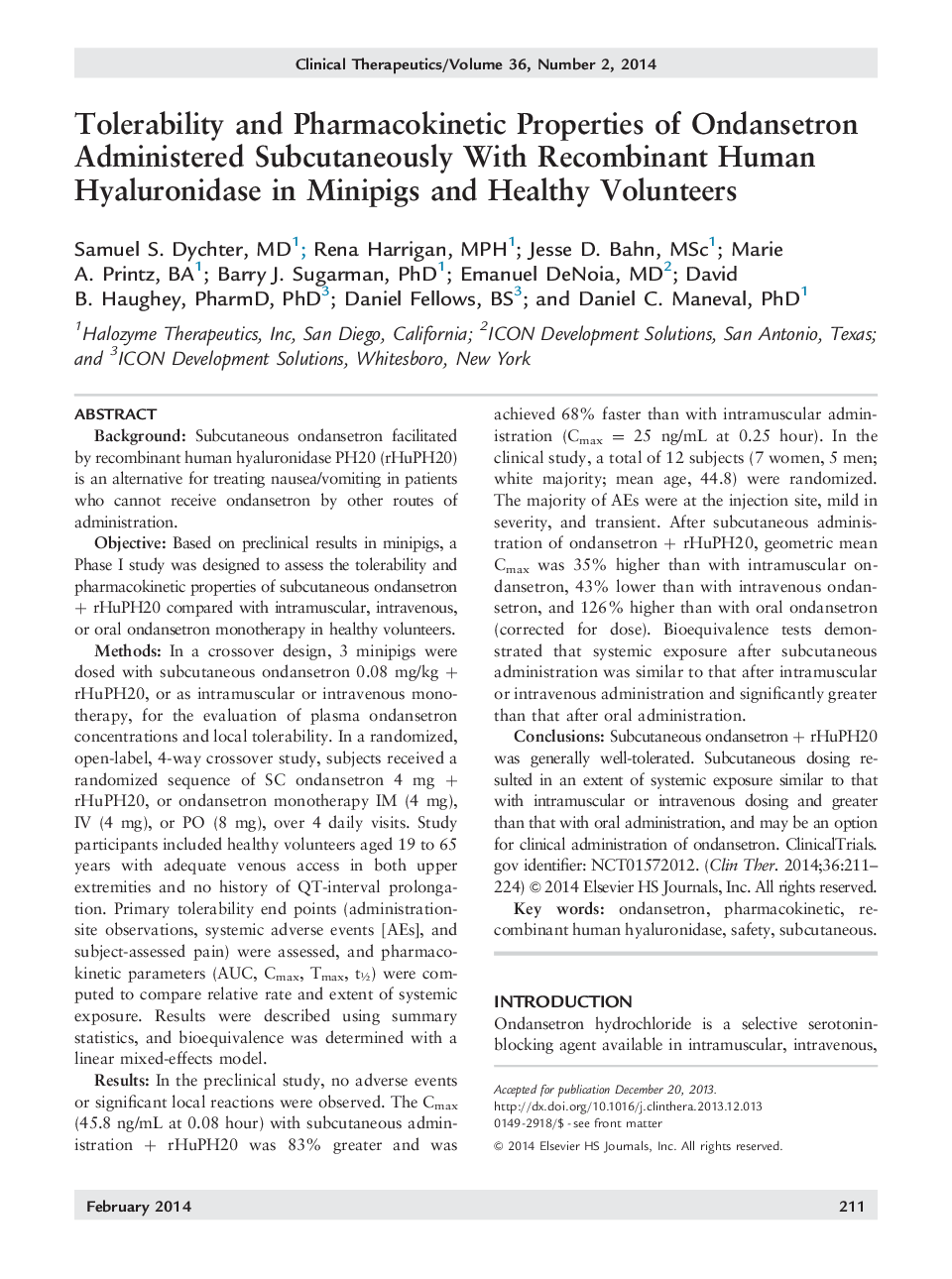| کد مقاله | کد نشریه | سال انتشار | مقاله انگلیسی | نسخه تمام متن |
|---|---|---|---|---|
| 5825569 | 1119910 | 2014 | 14 صفحه PDF | دانلود رایگان |
BackgroundSubcutaneous ondansetron facilitated by recombinant human hyaluronidase PH20 (rHuPH20) is an alternative for treating nausea/vomiting in patients who cannot receive ondansetron by other routes of administration.ObjectiveBased on preclinical results in minipigs, a Phase I study was designed to assess the tolerability and pharmacokinetic properties of subcutaneous ondansetron + rHuPH20 compared with intramuscular, intravenous, or oral ondansetron monotherapy in healthy volunteers.MethodsIn a crossover design, 3 minipigs were dosed with subcutaneous ondansetron 0.08 mg/kg + rHuPH20, or as intramuscular or intravenous monotherapy, for the evaluation of plasma ondansetron concentrations and local tolerability. In a randomized, open-label, 4-way crossover study, subjects received a randomized sequence of SC ondansetron 4 mg + rHuPH20, or ondansetron monotherapy IM (4 mg), IV (4 mg), or PO (8 mg), over 4 daily visits. Study participants included healthy volunteers aged 19 to 65 years with adequate venous access in both upper extremities and no history of QT-interval prolongation. Primary tolerability end points (administration-site observations, systemic adverse events [AEs], and subject-assessed pain) were assessed, and pharmacokinetic parameters (AUC, Cmax, Tmax, t½) were computed to compare relative rate and extent of systemic exposure. Results were described using summary statistics, and bioequivalence was determined with a linear mixed-effects model.ResultsIn the preclinical study, no adverse events or significant local reactions were observed. The Cmax (45.8 ng/mL at 0.08 hour) with subcutaneous administration + rHuPH20 was 83% greater and was achieved 68% faster than with intramuscular administration (Cmax = 25 ng/mL at 0.25 hour). In the clinical study, a total of 12 subjects (7 women, 5 men; white majority; mean age, 44.8) were randomized. The majority of AEs were at the injection site, mild in severity, and transient. After subcutaneous administration of ondansetron + rHuPH20, geometric mean Cmax was 35% higher than with intramuscular ondansetron, 43% lower than with intravenous ondansetron, and 126% higher than with oral ondansetron (corrected for dose). Bioequivalence tests demonstrated that systemic exposure after subcutaneous administration was similar to that after intramuscular or intravenous administration and significantly greater than that after oral administration.ConclusionsSubcutaneous ondansetron + rHuPH20 was generally well-tolerated. Subcutaneous dosing resulted in an extent of systemic exposure similar to that with intramuscular or intravenous dosing and greater than that with oral administration, and may be an option for clinical administration of ondansetron. ClinicalTrials.gov identifier: NCT01572012.
Journal: Clinical Therapeutics - Volume 36, Issue 2, 1 February 2014, Pages 211-224
